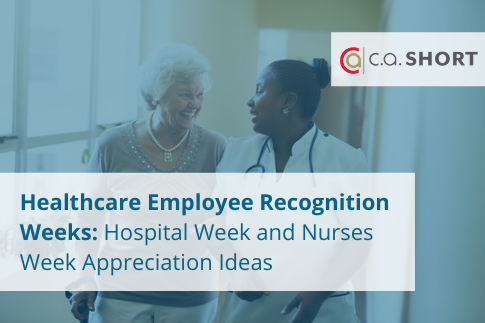Recognition, regardless of the company or organization, is a critical yet often overlooked facilitator of motivation, encouragement, and engagement in the workplace. The positive impact of recognition on both employee satisfaction and organizational success cannot be overstated.
There are various models of recognition, ranging from peer-to-peer initiatives to manager-led programs, as well as hybrid models that combine both. Depending on the model in place, recognition can come from a colleague at your desk, a department manager, or even company executives.
Depending on the needs of the company, certain recognition models can be used to maximize benefits. To determine the best course of action, it is crucial to answer one important question: From whom do employees most desire recognition? Once answered, companies everywhere can begin to implement recognition models that produce eye-opening benefits.
Recognition Models: A Comparative Analysis
Peer-to-Peer Recognition
Peer-to-peer recognition occurs when coworkers or teammates recognize one another for their strengths, abilities, attitudes, and more. Peer recognition gives everyone an opportunity to empower their fellow coworkers in day-to-day work life. This results in stronger, healthier bonds between members of a team. Better communication, collaboration, and overall success is made possible through peer recognition programs.
Three Benefits of Peer-to-Peer Recognition
- Reduces Employee Turnover
Employee turnover is a costly deterrent to the success of a company. One effective strategy to mitigate this issue is through the implementation of peer recognition programs.
By fostering a culture where employees feel recognized, engaged, and valued, organizations can cultivate greater loyalty and job satisfaction.
When colleagues actively support and acknowledge one another in daily interactions, it enhances morale and increases the likelihood that employees will remain committed to their roles.
- Increases Engagement, Motivation, and Productivity
Rather than relying solely on managers or leaders for recognition, peer recognition allows for acknowledgment to occur organically and at any time.
Everyday tasks that might otherwise go unnoticed by leadership can be observed and appreciated by colleagues, fostering a culture of encouragement. This continuous reinforcement contributes to increased motivation and a greater willingness among employees to go above and beyond in their roles.
- Builds Collaboration and Teamwork
Teams now dedicate 50% more time to collaborative work than they did five years ago, displaying the growing importance to foster strong, interdependent teams.
Peer recognition plays a critical role in cultivating such teams by creating deep and personal connections among members. When employees are empowered by peer-driven acknowledgment rather than relying solely on top-down recognition, they tend to be more cooperative, less competitive, and better prepared to navigate daily challenges.
Manager-led Recognition
Manager-led recognition, also known as top-down recognition, refers to the process in which individuals in higher organizational positions, such as managers or executives, acknowledge the contributions or achievements of employees at lower levels.
This form of recognition can take various forms, including positive feedback during one-on-one meetings, public recognition in team meetings or company-wide events, or through company-wide email acknowledgments.
Unlike peer recognition, manager-led recognition operates in a distinct manner, offering unique benefits and potential drawbacks.
Three Benefits of Manager-led Recognition
- Boosts Employee Engagement
Employee recognition, at any level, is a sure-fire way to increase engagement in the workplace.
Much like peer recognition, manager-led recognition gets employees excited and ready to accomplish new things. In fact, “more than 80% of employees said they work harder when appreciated, and nearly 7 in 10 (69%) stated recognition and rewards keep them loyal to their employers.”
- Inspires Teams and Departments
Recognition from managers, higher-ups, or leaders can supercharge teams to perform at their absolute best, guiding them down a path that aligns with the company’s values and objectives.
Managers who recognize both individual contributions and the collective efforts of the team foster a sense of camaraderie and unity among team members.
- Creates Content and Connected Employees
Manager-led recognition is essential for boosting both team and organizational morale.
Employees and teams who are consistently acknowledged for their efforts are more likely to experience higher job satisfaction, engagement, and commitment. This, in turn, fosters greater consistency and accountability in their daily tasks.
According to a Gallup survey, organizations that prioritize recognition and praise from leadership can see increases in productivity and revenue ranging from 10-20%.
Three Downsides of Manager-led Recognition
- Generates Inauthentic Praise
Manager-led recognition can sometimes come across as insincere or obligatory, as if the praise is more of a formal requirement than a genuine acknowledgment of an employee’s achievements.
This can be further compounded by a lack of understanding of the employee's full scope of responsibilities, leading to recognition that feels awkward or misinformed.
In many cases, managers may not fully grasp the significance of an employee’s role within the organization or what true excellence looks like within the team or department.
- Creates Feelings of Obligatory Thanks
Recognition from superiors is often pre-scheduled rather than spontaneous, which can lead to frustration and feelings of being undervalued, especially when employees are most deserving of acknowledgment.
Planned praise tends to be less frequent, less meaningful, and at times may even come across as insincere or obligatory.
- Stifles Potential Relationships
When employees receive recognition from managers but not from their peers, it can lead to feelings of isolation and disconnection from the team.
A lack of peer acknowledgment may contribute to feelings of being undervalued or overlooked by colleagues.
Additionally, when one individual is singled out for praise while others are ignored, it can potentially discourage others from performing their duties to the best of their abilities.
Hybrid Recognition
Hybrid recognition models integrate multiple recognition strategies into a single framework, aiming to leverage the strengths of each approach while mitigating their respective limitations. These models are designed to combine the most effective elements of various recognition methods, such as peer-to-peer and manager-led recognition, to create a comprehensive and balanced system.
Often described as offering the "best of both worlds," hybrid models provide a versatile and inclusive solution for employee recognition.
Three Benefits of Hybrid Recognition
- Diversifies Recognition
Hybrid models can enhance employee recognition by diversifying the sources of acknowledgment. Instead of relying on a single manager, team, or department, recognition can come from multiple channels.
If one individual or group misses the opportunity to recognize a peer on any given day, there is a greater chance that another source can step in to ensure that employees still feel valued and appreciated.
- Mitigates Downsides as a Whole
By combining multiple recognition strategies into one cohesive model, you can minimize the limitations of any single approach and leverage the strengths of each.
This integration helps balance out potential drawbacks, ensuring a more comprehensive and effective recognition system.
- Covers All Bases
Hybrid models provide a variety of recognition strategies, increasing the likelihood that employees will be consistently acknowledged for their contributions.
With the right systems in place, you can be confident that recognition will happen regularly and from multiple sources, ensuring that employees are celebrated in diverse ways and at different times.
One Downside of Hybrid Recognition
- Spreads Benefits Thin
Hybrid models can sometimes undermine their own effectiveness. While they offer a mix of recognition strategies, this can lead to a lack of focus, resulting in multiple approaches that are less cohesive and, at times, half-hearted.
Rather than strengthening recognition efforts, the complexity of hybrid models may dilute their impact, making them less effective and responsive. In some cases, a more streamlined approach can be far more powerful.
When and Where Each Model Works Best
The When
A key aspect of effective employee recognition is timing. Asking "when?" is crucial—untimely recognition can confuse employees or even backfire, leading to the opposite of the desired effect. According to Allyson Hay, Director of Human Resources at Innovo Benefits Group, timely and well-placed acknowledgment is essential for recognition to be truly impactful.
Performance-Based Recognition
Recognizing employees for their performance is a widely used and effective way to show appreciation for their dedication and hard work.
Whether it's celebrating the successful completion of a project or the achievement of a professional goal, there are countless ways to acknowledge employees' contributions.
Manager-led recognition and hybrid recognition, in particular, are powerful strategies for making these acknowledgments meaningful and impactful.
Effort-Based Recognition
The great thing about effort-based recognition is that they can be tied to both small, everyday tasks and larger accomplishments.
Recognizing employees for going above and beyond—whether by helping a colleague, completing a key project, or excelling in other areas—demonstrates genuine appreciation for their contributions.
Peer-to-peer and hybrid recognition are especially powerful in this context, as they both foster a supportive and collaborative work culture.
Milestone-Based Recognition
Milestones offer a fantastic opportunity to recognize and celebrate your employees. Whether it’s a work anniversary, birthday, or even a year-end review, these moments can make a big impact.
It’s also important to acknowledge personal milestones that aren’t directly tied to the job—this shows employees and team members that you value them not just as workers, but as people.
Manager-led, peer-to-peer, and hybrid recognition are highly effective in making these celebrations meaningful and genuine.
The Where
Choosing the right setting for employee recognition is just as important as timing it correctly. Even if the timing is perfect, an inappropriate environment can undermine the impact of recognition efforts. Both the when and the where are crucial—neither can fully unlock the potential of a recognition program without the other. Ultimately, the ideal setting for recognition depends on the specific model being used and the preferences of your employees.
Peer-to-Peer Recognition
Peer-to-peer recognition is most effective—and feels most natural—when it’s shared privately, rather than broadcast to the entire company.
Whether it’s a quick word in the hallway, a note at your desk, or a simple email, peer recognition stands out because it’s personal, meaningful, and often comes from those you’re closest with at work.
A genuine "great job" from a teammate just across the room can do wonders for an employee’s motivation and morale, giving them a real boost to keep doing their best.
Manager-led Recognition
Manager-led recognition is often most effective in public settings, such as meetings or company events, where leaders can acknowledge your achievements in front of colleagues. This public recognition not only boosts morale but also highlights your contributions.
However, it's important to recognize that some employees may feel uncomfortable with public praise. To address this, manager-led recognition can also be tailored to a more personal approach, such as a private one-on-one conversation, ensuring everyone feels valued in a way that aligns with their preferences.
Hybrid Recognition
Hybrid recognition models can be tricky, as the best place to give recognition ultimately depends on the person giving it—is it a manager, coworker, higher-up, etc.?
Depending on the recognition giver and the preferences of the recognition receiver, the setting for hybrid models can occur anywhere from a one-on-one to a company-wide event.
So You Know
While each recognition model excels in certain contexts, there is no strict guideline that dictates which model should be used in a particular setting. The effectiveness and suitability of any recognition approach ultimately depends on the unique needs of the company, team, or individual.
Recognition, A Simple Act with Lasting Impact
Employee recognition is a vital factor in both the well-being of employees and the overall success of organizations. Regardless of the recognition model implemented, it's clear that even the smallest gestures can have a meaningful impact on employees’ lives.
Whether it’s peer-to-peer recognition to enhance job satisfaction and teamwork, manager-led recognition to motivate and foster deeper connections, or a hybrid approach to serve multiple purposes, recognizing employees at the right time and in the right way can truly transform the workplace experience.



.png?width=70&name=Untitled%20design%20(11).png)
.jpeg)

.jpg)



SHARE